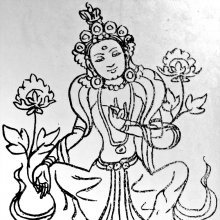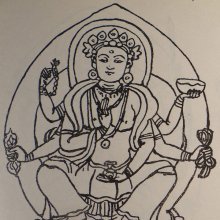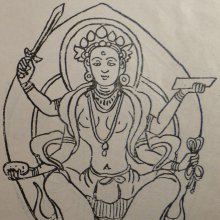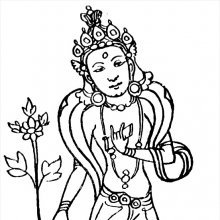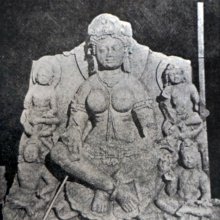Bhadrasana, Bhadra-asana, Bhadrāsana: 22 definitions
Introduction:
Bhadrasana means something in Hinduism, Sanskrit, Jainism, Prakrit, the history of ancient India, Marathi. If you want to know the exact meaning, history, etymology or English translation of this term then check out the descriptions on this page. Add your comment or reference to a book if you want to contribute to this summary article.
Images (photo gallery)
In Hinduism
Shilpashastra (iconography)
Source: Google Books: Elements of Hindu iconographyIn the Bhadrāsana (भद्रासन) the legs are crossed as in the kūrmāsana, and the right and the left big toes are caught hold of by the right and the left hands respectively.
Source: Shodhganga: The significance of the mūla-beras (śilpa)Bhadrāsana (भद्रासन) refers to a type of Āsana (sitting poses), according to Ganapati Sthapati in his text Ciṟpa Cennūl, as defined according to texts dealing with śilpa (arts and crafs), known as śilpaśāstras.—In the bhadrāsana, the heels of the legs, which cross each other, are placed under the testes and the hands hold the two big toes of the feet.
Rao describes four types of āsanas or pīṭhas, viz., bhadrapīṭha (bhadrāsana), kūrmāsana, pretāsana and siṃhāsana. The height of the first is divided into 16 parts, of which one forms the thickness of the upana or the basal layer; four, of the jagati or the next higher layer; three, of the kumuda; one, of the pattika; three, of the kantha; one, of the second pattika; two, of the broader mahāpattika; and one, of the ghṛtavari, the top-most layer. The bhadrāsana of an image does not seem to have been such an elaborate āsana or pītā.

Shilpashastra (शिल्पशास्त्र, śilpaśāstra) represents the ancient Indian science (shastra) of creative arts (shilpa) such as sculpture, iconography and painting. Closely related to Vastushastra (architecture), they often share the same literature.
Yoga (school of philosophy)
Source: Wisdom Library: YogaBhadrāsana (भद्रासन) is one of the eighty-four āsanas (postures) taught by Śiva, according to the Haṭharatnāvalī 3.7-20. It is said that Ādinātha (Śiva) hand-picked 84 yoga postures from 84,00,000 living beings and taught them for the purpose of introducing physical health and well-being to the human body. The compound bhadrāsana translates to bhadra (good fortune) and āsana (posture).
The 17th-century Haṭharatnāvalī is a Sanskrit reference book dealing with these āsanas (e.g., bhadrāsana) which form a major constituent of the haṭhayoga practice. It was written by Śrīnivāsa.
Source: Google Books: The Hatha Yoga PradipikaBhadrāsana (भद्रासन) refers to an āsana (posture) taught by Śiva. It is one of the first four out of 84 total, thus one of the most essential, according to Haṭhayogapradīpikā I.55-60.—Accordingly, “Place the heels on either side of the seam of the Perineum, keeping the left heel on the left side and the right one on the right side, hold the feet firmly joined to one another with both the hands. This bhadrāsana is the destroyer of all the diseases”.
Also, “The expert Yogīs call this gorakṣāsana. By sitting with this āsana, the Yogī gets rid of fatigue. The nādis should be cleansed of their impurities by performing the mudrās, etc., (which are the practices relating to the air) āsanas, Kumbhakas and various curious mudrās.”
The 15th-century Haṭhayogapradīpikā by Svātmārāma is one of the oldest extant texts dealing with haṭhayoga: an ancient form of meditation founded by Matsyendranātha. The first chapter of this book describes various āsanas (e.g., bhadra-āsana).
Source: archive.org: Yoga Tradition of the Mysore PalaceBhadrāsana (भद्रासन) is a type of standing posture (āsana), according to verse 77 of the Śrītattvanidhi.—Accordingly, “Place the left ankle on the right side of the perineum and the righton the left side of the perineum. Hold the sides of the feet firmly with the two hands. This is bhadrāsana, the fortunate āsana”.
The 19th-century Śrītattvanidhi is a sanskrit treatise describing 80 primary āsanas, or ‘posture’ (e.g., bhadra-āsana) and several additional ones.
(Also see) Haṭhapradīpikā I.53-54 and Gheraṇḍasaṃhitā II.9-10.
Source: archive.org: Gheranda SamhitaBhadrāsana (भद्रासन) is one of the thirty-two āsanas (postures) taught in the second chapter of the Gheraṇḍasaṃhitā: “Carefully placing the ankles in the reverse manner under the scrotum; crossing the hands behind the back holding the big toes and adopting the Jālandhara (bandha), one should gaze at the tip of the nose This is Bhadrāsana which destroys all diseases”.
Bhadrāsana is one of the selected 32 postures amongs 8,400,000 total mentioned by Śiva, according to Gheraṇḍasaṃhitā 2.1-2, “In all, there are as many Āsanas as species of animals. Eighty-four lacs of them are mentioned by Śiva. Out of them, 84 are regarded as important and among these 84, again 32 are good (enough) in this world of mortal beings”.
The 17th-century Gheraṇḍasaṃhitā (mentioning bhadra-āsana) is one of the three classic texts of Haṭha-yoga: a major branch of Yoga, sharing similarities with the Yoga system taught by Patañjali, though claiming its own mythical founder known as Matsyendranātha. This gheraṇḍa-saṃhitā is an encyclopedic Sanskrit treatise describing thirty two such āsanas.

Yoga is originally considered a branch of Hindu philosophy (astika), but both ancient and modern Yoga combine the physical, mental and spiritual. Yoga teaches various physical techniques also known as āsanas (postures), used for various purposes (eg., meditation, contemplation, relaxation).
Shaktism (Shakta philosophy)
Source: academia.edu: The Śāradātilakatantra on YogaBhadrāsana (भद्रासन) refers to one of the five āsanas (postures) explained by Lakṣmaṇadeśika in his 11th-century Śaradātilaka verse 25.13-14ab.—“He should place both ankles very firmly on either side of the perineum; he should hold the two heels of [his] feet steady with both hands below the scrotum. [Thus is] taught the auspicious posture (bhadrāsana); it is highly honoured by Yogins”.

Shakta (शाक्त, śākta) or Shaktism (śāktism) represents a tradition of Hinduism where the Goddess (Devi) is revered and worshipped. Shakta literature includes a range of scriptures, including various Agamas and Tantras, although its roots may be traced back to the Vedas.
Natyashastra (theatrics and dramaturgy)
Source: Shodhganga: Gati in theory and practiceBhadrāsana (भद्रासन) refers to “positions taken by dancers”, according to the Nāṭyaśāstra (chapter IV, commentary p.193.).—[While discussing the elements of Āṅgika-abhinaya (gestural representation) in Nāṭya-śāstra]—Piṇḍībandhas are the group formations of dancers. The piṇḍī attached to the different gods and goddesses are named after their own banners. The origin of piṇḍī is of three fold namely yantṛ (which strings together) bhadrāsana (positions taken by dancers) and śikṣāyoga (exercises based on karaṇas and aṅgahāras). The piṇḍī are of four varieties: piṇḍī (lump), śrṅkhalikā (cluster or chain), latābandha (together like a creeper) and bhedyaka (group formation of dancers where-in individuals cannot be identified)

Natyashastra (नाट्यशास्त्र, nāṭyaśāstra) refers to both the ancient Indian tradition (shastra) of performing arts, (natya—theatrics, drama, dance, music), as well as the name of a Sanskrit work dealing with these subjects. It also teaches the rules for composing Dramatic plays (nataka), construction and performance of Theater, and Poetic works (kavya).
In Jainism
General definition (in Jainism)
Source: archive.org: Trisastisalakapurusacaritra1) Bhadrāsana (भद्रासन) refers to the “throne” and represents one of the “eight auspicious thins” in Jainism, according to chapter 1.2 [ādīśvara-caritra] of Hemacandra’s 11th century Triṣaṣṭiśalākāpuruṣacaritra: an ancient Sanskrit epic poem narrating the history and legends of sixty-three illustrious persons in Jainism.
Accordingly: “[...] Then, after circumambulating it, he ascended his aerial car, like his own lofty pride, by the east steps. [...] Then Śakra’s Śāmānikas, like other forms of Śakra, ascended by the north steps and took their proper seats. [...] In front of the Lord of Paulomī (Śakra) seated on the lion-throne shone eight groups of the eight auspicious things, [viz., bhadrāsana], etc. [...]”.
2) Bhadrāsana (भद्रासन) or simply Bhadra is the name of a posture (āsana), according to chapter 2.1.—Accordingly, “the elephant of kings (i.e., Vimalavāhana) dismounted from the elephant’s shoulder and entered the garden, like a lion a mountain-cave. [...] He saw monks there, too, some in the [viz., bhadrāsana-posture, ...] some engaged in kāyotsarga, and some in ukṣa-posture, indifferent to the body, who had carried out their vows in the midst of numerous attacks, like soldiers in battles, victorious over internal enemies, enduring trials, powerful from penance and meditation [...] The King, with devotion sprouted in the guise of horripilation, as it were, approached Ācārya Arindama and paid homage to him”.
Source: Shodhganga: A cultural study on the jain western Indian illustrated manuscriptsBhadrāsana (भद्रासन, “throne”).—One of the eight providential symbols, or, aṣṭamaṅgala.—Bhadrāsana is offered for the worshipful feet of Jineśvara.
Source: Singhi Jain Series: Ratnaprabha-suri’s Kuvalayamala-kathaBhadrāsana (भद्रासन) or Bhadrāsanakanyā refers to one of the Eight auspicious Girls—(representing the eight celestial nymphs of Indra’s heaven) which are mentioned as holding various attributes, according to Uddyotanasūri in his 8th-century Kuvalayamālā (a Prakrit Campū, similar to Kāvya poetry).—Page 93.17-8: There is a list of Eight auspicious girls holding respectively sprouted water-jars, fan-palm, fly-whisk, parasol, mirror, mṛdaṅga, harp, drum and cloth and ornaments. These were regarded as eight celestial nymphs of Indra’s heaven and frequently referred in literature as aṣṭakanyā or sabhā-kanyā. [...] The list of eight auspicious girls also occurs in the Lalitavistara (VII, p. 71) where their names are: [e.g., Bhadrāsana-kanyā] [...] These were also known as the eight women of Indra’s court (aṣṭau yoṣitaḥ or aṣṭau apsarasaḥ).

Jainism is an Indian religion of Dharma whose doctrine revolves around harmlessness (ahimsa) towards every living being. The two major branches (Digambara and Svetambara) of Jainism stimulate self-control (or, shramana, ‘self-reliance’) and spiritual development through a path of peace for the soul to progess to the ultimate goal.
India history and geography
Source: Cologne Digital Sanskrit Dictionaries: Indian Epigraphical GlossaryBhadra-asana.—(EI 25), a throne. Note: bhadra-asana is defined in the “Indian epigraphical glossary” as it can be found on ancient inscriptions commonly written in Sanskrit, Prakrit or Dravidian languages.

The history of India traces the identification of countries, villages, towns and other regions of India, as well as mythology, zoology, royal dynasties, rulers, tribes, local festivities and traditions and regional languages. Ancient India enjoyed religious freedom and encourages the path of Dharma, a concept common to Buddhism, Hinduism, and Jainism.
Languages of India and abroad
Marathi-English dictionary
Source: DDSA: The Molesworth Marathi and English Dictionarybhadrāsana (भद्रासन).—n S (Happy or fortunate seat.) A throne. 2 A posture of devotees.
Source: DDSA: The Aryabhusan school dictionary, Marathi-Englishbhadrāsaṇa (भद्रासण).—n A throne. A posture of devotees.
Marathi is an Indo-European language having over 70 million native speakers people in (predominantly) Maharashtra India. Marathi, like many other Indo-Aryan languages, evolved from early forms of Prakrit, which itself is a subset of Sanskrit, one of the most ancient languages of the world.
Sanskrit dictionary
Source: DDSA: The practical Sanskrit-English dictionaryBhadrāsana (भद्रासन).—
1) a chair of state, splendid seat, a throne.
2) a particular posture in meditation.
Derivable forms: bhadrāsanam (भद्रासनम्).
Bhadrāsana is a Sanskrit compound consisting of the terms bhadra and āsana (आसन).
Source: Cologne Digital Sanskrit Dictionaries: Benfey Sanskrit-English DictionaryBhadrāsana (भद्रासन).—n. 1. a throne. 2. a peculiar posture, in which abstract meditation is performed by a devotee.
Bhadrāsana is a Sanskrit compound consisting of the terms bhadra and āsana (आसन).
Source: Cologne Digital Sanskrit Dictionaries: Cappeller Sanskrit-English DictionaryBhadrāsana (भद्रासन).—[neuter] splendid seat, throne.
Source: Cologne Digital Sanskrit Dictionaries: Monier-Williams Sanskrit-English Dictionary1) Bhadrāsana (भद्रासन):—[from bhadra > bhand] n. a splendid seat, throne, [Yājñavalkya; Mahābhārata] etc.
2) [v.s. ...] a [particular] posture of a devotee during meditation, [Sarvadarśana-saṃgraha]
Source: Cologne Digital Sanskrit Dictionaries: Yates Sanskrit-English DictionaryBhadrāsana (भद्रासन):—[bhadrā+sana] (naṃ) 1. n. A throne; posture of profound meditation.
[Sanskrit to German]
Sanskrit, also spelled संस्कृतम् (saṃskṛtam), is an ancient language of India commonly seen as the grandmother of the Indo-European language family (even English!). Closely allied with Prakrit and Pali, Sanskrit is more exhaustive in both grammar and terms and has the most extensive collection of literature in the world, greatly surpassing its sister-languages Greek and Latin.
Kannada-English dictionary
Source: Alar: Kannada-English corpusBhadrāsana (ಭದ್ರಾಸನ):—
1) [noun] = ಭದ್ರಪೀಠ - [bhadrapitha -] 1.
2) [noun] a particular posture for meditation.
Kannada is a Dravidian language (as opposed to the Indo-European language family) mainly spoken in the southwestern region of India.
See also (Relevant definitions)
Partial matches: Bhadra, Asana.
Ends with: Virabhadrasana.
Full-text (+14): Asana, Pattiratanam, Vinyasya, Agrapujeca Mana, Nandipataha, Anaduha, Pattiracanam, Yaduvamsha, Vajrasana, Vashyatara, Bhadraka, Gorakshasana, Aryatara, Ashtamangala, Yantri, Sthapya, Shrinkhalika, Latabamdha, Shikshayoga, Pindi.
Relevant text
Search found 23 books and stories containing Bhadrasana, Bhadra-asana, Bhadrāsana, Bhadra-āsana, Bhadrāsaṇa; (plurals include: Bhadrasanas, asanas, Bhadrāsanas, āsanas, Bhadrāsaṇas). You can also click to the full overview containing English textual excerpts. Below are direct links for the most relevant articles:
The Indian Buddhist Iconography (by Benoytosh Bhattachacharyya)
Figure 170 - Emanations of Amoghasiddhi: Vaśyatārā (Vaśya Tārā)
108 forms of Avalokiteśvara (25): Utnauti Lokeśvara
Puranic encyclopaedia (by Vettam Mani)
Yoga-sutras (with Vyasa and Vachaspati Mishra) (by Rama Prasada)
Varahi Tantra (English Study) (by Roberta Pamio)
Chapter 26 - Haṭhayoga (according to the Haṭhayogapradīpikā) < [Summary of the Vārāhī Tantra]
Samkhya thoughts in the Mahabharata (by Shini M.V.)
Yoga Philosophy in Śānti-parva < [Chapter 3 - The Philosophical Tenets in the Śānti-parva]
Related products
